Rice sheath blight

Rice sheath blight disease symptoms
Hazard characteristics:
Mainly for the damage of the leaf sheath, followed by the leaves.
Leaf sheath infection: In the initial stage, a dark green water-immersed edge is formed at the surface near the water surface, and then gradually enlarges into an elliptical or moiré shape, the edge is dark brown, the middle part is grayish white and translucent, and when wet, it is grayish green.
Infected with leaves: the lesions are also cloud-like, with yellowish edges. When the disease is fast, the lesions are stained green and the leaves are quickly rotted.
Stalk infection: Symptoms like leaves, later yellow-brown, easy to fold.
Panicle neck disease: the first wet-blue-black, often can not head, more ears in the valley, thousands of weight decreased. When the humidity is high, the disease minister produces white reticular hyphae, and then forms sclerotia.
Control method:
1 Select resistant (resistant) disease varieties; salvage sclerotia, reduce bacterial sources; scientifically manage water, implement the principle of “pre-shallow, medium-sun, and post-wet†water, avoid long-term deep irrigation or excessive field drying; rational fertilization, implementation The principle of “applying sufficient base fertilizer, early application of topdressing and flexible topdressing†to enhance plant growth; rational close planting and increased permeability.
2 The rate of late-stage disease points is 15%, that is, the application of the drug is controlled. The following agents can be used: benzoyl-propiconazole, epoxiconazole, or hexaconazole.
3 At the booting stage, when the incidence rate of the plexus reaches 10%, the condition still develops, and the drug is sprayed once with 2,400-3,000 times of 30% benzyl-propiconazole emulsifiable concentrate.
rice blast

Symptoms of rice blast disease
Hazard characteristics:
Because of the damage period and location, it is divided into nursery, leafhopper, thrift, panicle, and grain.
Nursery: occurred before the three leaves, the diseased yellow-brown died.
Leaf sputum: Chronic lesions, mostly fusiform, brown at the edges, grayish-white at the center, yellow halo, with brown necrotic lines extending to both ends; acute lesions, usually occurring on susceptible varieties, forming dark green near-circular Or elliptical lesions, brown mold on both sides of the leaves.
Thrift: often occurs after heading, the initial brown spots appear, and then gradually expand the knot, making the whole section black and necrotic, easy to break, the early formation of white ears.
Panicle neck: Initially formed a small brown spot, which expands to make the neck of the ear brown, also causing white ears, causing the late Shigaya.
Grain mites: brownish brown edges and grayish white spots in the middle.
Control method:
1 Selection of resistant (resistant) disease varieties; scientific tube water, base fertilizer foot, early fattening, application of fully decomposed farmyard manure, increased application of phosphorus and potassium fertilizer, enhance plant disease resistance; reasonable close planting, increase permeability.
2 In the early stage of the disease, the control of Indigo, Sulfur, Tricyclazole and Tricyclazole was used. The severely ill areas should be controlled twice, with an interval of 7 to 10 days.
Rice bacterial blight

Rice bacterial blight disease symptoms
Hazard characteristics:
It can be harmed throughout the growth period, the most serious damage in the seedling stage and tillering stage, and all organs can be infected, and the leaves are most susceptible to disease.
1 Generally, there are chlorotic and yellow spots. When the weather is wet, the milky white spots are visible on the diseased leaves. After drying, they form yellow small rubber particles, which are easy to fall off. At the beginning of the tillering stage, the dead heart seedlings appeared, and the leaves of the diseased plant heart or the leaves of the heart layer 1 to 2 layers showed signs of water loss, reeling, and bruising, and finally died.
2 After the bacterial leaf blight is formed, the other leaves are gradually curled up. Finally, the whole plant is dead, peeling off the heart of the new blue roll or the broken stem or cutting off the diseased leaf. White bacteria pus spilled. Can be divided into leaf dry, acute wilting, yellowing three types.
Control method:
1 Strengthen the management of fertilizer and water, wet irrigation in the rainy season, base fertilizer, early fattening, application of fully decomposed farmyard manure, increase of phosphorus and potassium fertilizer, enhance plant disease resistance; timely and moderate roasting.
2 Soaking seeds: soaking seeds with immersed fruit or strong chlorine, and germination after routine washing with strong chlorin.
3 In the early stage of the disease, it is possible to use leaf cumin, chlorobromoisocyanuric acid, and streptomycin sulfate for agricultural use.
Rice bacterial leaf streak
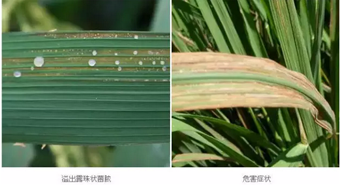
Symptoms of bacterial leaf streak disease in rice
Hazard characteristics:
1 Rice bacterial leaf streak is mainly harmful to leaves. It is a dark green water-immersed translucent small spot, which rapidly expands into a yellow-brown thin line or a short dotted line streak between the veins, and the lesions are infiltrated green at both ends.
2 Many spots of yellow-like pus are often spilled on the lesions. After drying, they are yellow gelatinous granules, which are not easy to fall off. When the disease is serious, they merge into irregular yellow to white spots, similar to white leaves, but many are visible to light. Translucent strips.
3 When the disease is severe, the leaves are curled, and the field is yellowish white, causing early death or inability to head.
Control method:
1 Take comprehensive measures based on prevention: strengthen quarantine, control disease transmission; select resistant varieties; scientifically manage water, base fertilizer, topdressing early, apply fully decomposed farmyard manure, increase phosphorus and potassium fertilizer, and enhance plant disease resistance Reasonable close planting to increase permeability.
2 Soaking seeds: The seeds are pre-soaked with water for 12 hours, then soaked with 85% trichloroisocyanuric acid wettable powder for 300 hours, and then germinated for germination.
3 In the early stage of the disease, chlorobromoisocyanuric acid, neutrophin, trichloroisocyanuric acid, etc. can be used for prevention and treatment.
Rice false disease
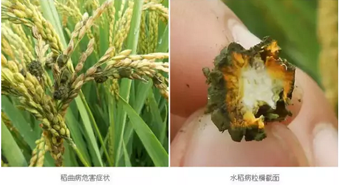
Rice smut disease symptoms
Hazard characteristics:
1 occurs only in the ear, which is harmful to the grain. The mycelial mass is formed in the affected grain, and the inner and outer buds are split, revealing pale yellow block-like protrusions, and then gradually engulfing the whole glory, showing a black-green color.
2 Initially, a layer of film is wrapped, and then ruptured, and the dark green powder is scattered, that is, the thick sputum spores of the pathogen, and some of them are black flat sclerotia on both sides, and the wind and rain are easy to fall off.
Control method:
1 Selection of resistant (resistant) disease varieties; avoiding disease field retention, deep ploughing and burying sclerotia, removing and destroying diseased grains at the time of onset; scientific tube water, bottom fertilizer foot, top dressing early, applying fully decomposed farmyard manure, increasing phosphorus application Potassium fertilizer, enhance plant disease resistance; reasonable close planting, increase permeability.
2 The seed dressing can be mixed with 50 ml of 3% diphenyl ether methylcyclazole suspension seed coating agent.
3 In the early stage of the disease, tebuconazole, trichobacteria, tebuconazole, nitrile benzoxazole, etc. can be used for prevention and treatment.
Rice bacterial base rot
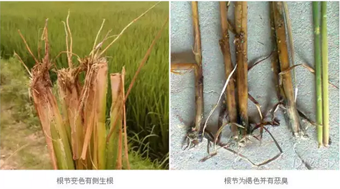
Symptoms of bacterial bacterial rot disease in rice
Hazard characteristics:
1 Mainly damage the root section and stem base of rice. In general, the tillering stage of rice begins to occur. In the initial stage, water-immersed elliptical spots are formed on the sheath of the proximal soil stem, and then expanded into irregular large spots with brown edges and white at the center.
2 Severe diseased plant heart leaf blue roll, after the yellow, like aphid damage to the heart and seedlings, then the roots of the diseased plant become black and rot, easy to pull off, have foul odor, even the leaves from the top down, yellow, even the whole plant .
Control method:
1 Selection of resistant (resistant) disease varieties; scientific tube water, base fertilizer foot, early fattening, application of fully decomposed farmyard manure, increased application of phosphorus and potassium fertilizer, enhance plant disease resistance; reasonable close planting, increase permeability.
2 In the early stage of the disease, it can be controlled with thiabium copper, thidium copper and 50% trichloroisocyanuric acid, spray once every 5 to 7 days, and spray 3 to 4 times.
Rice black streaked dwarf disease
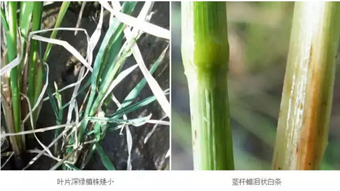
Symptoms of rice black streaked dwarf disease
Hazard characteristics:
The disease is mainly transmitted by the gray planthopper, followed by white-backed locusts and leucorrhea. The diseased plants increased in tillering, the leaves were short, wide and stiff, and the green leaves. The veins and stems of the leaves were initially waxy white, and then turned into brown short-striped tumors with no heading or small ears and poor fruiting.
Seedling stage: The heart leaves grow slowly, the leaves are short, wide, stiff, green, and the veins have irregular waxy white knobs, which turn dark brown. The roots are short, the plants are short, do not head, and often die early.
The disease at the tillering stage: the new hernia is the first symptom, the main stem and the early tiller can still extract the short diseased ear, but the diseased ear is confined in the leaf sheath.
Onset of jointing: the flag leaf is short, the neck is short, and the seed setting rate is low. There are short strips of tumor on the back and stem.
Control method:
1 Select resistant (resistant) disease varieties; remove weeds in the field.
2 timely control of insects, can be controlled by chlorantame, thiamethoxam, pymetrozine, buprofezin.
3 In the early stage of the disease, Ningnanmycin, lentinan, and chitosan can be used to alleviate.
Rice bacterial brown streak
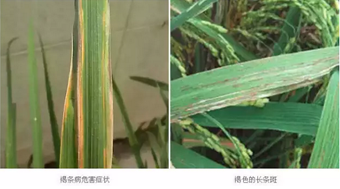
Symptoms of bacterial brown streak disease in rice
Hazard symptoms:
Both seedling and adult stages can be affected.
Inoculation at the seedling stage: brown spots appear on the leaves or sheaths, and then spread into purple-brown long-spotted spots with clear edges, sometimes as long as the leaves; the diseased seedlings withered or diseased leaves fall off, and the plants are short.
Adult stage disease: first in the middle of the blade of the mid-vein, the first water-immersed yellow-white, the posterior along the veins extended up to the tip of the leaf, down to the base of the sheath to form a yellow-brown to dark brown stripe, the disease tissue is brittle and easy to fold After the whole leaf curls die.
Leaf sheath infection: irregular plaques, yellowing afterwards, and finally all rot.
Heart disease: Can not be extracted, died in the leaf mites, pulled out the rancid smell, squeezed by the milky white to light yellow bacteria liquid.
Control method:
1 Establish a reasonable irrigation and drainage system to prevent flooding of rice fields and timely drainage; increase the application of organic fertilizers, and rationally cooperate with nitrogen, phosphorus and potassium fertilizers to enhance the disease resistance of plants.
2 In the early stage of the disease, it can be controlled by chlorobromoisocyanuric acid, neutrophin and trichloroisocyanuric acid.
Rice stripe disease
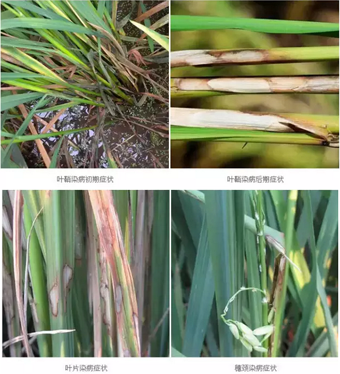
Rice stripe disease
Hazard symptoms:
It is only transmitted by the gray planthopper, and once it is poisoned, it can be used for life and through the egg.
Seedling stage: chlorotic yellow and white spots appear at the base of the initial plant heart, and then expand into yellow stripes parallel to the veins, and the stripes remain green; the diseased 糯, japonica and high-stalked japonica rice leaves are yellow and white, soft, curly and drooping, showing dryness Heart-shaped; dwarf glutinous rice is not heart-shaped, yellow-green inter-stripes appear, tillering is reduced, and the diseased plants die early.
The disease occurs at the tillering stage: the chlorotic macula appears in the base of the first leaf of the initial plant, and then forms irregular yellow-white streaks. The old leaves are not obvious, the diseased plants are often dry, the booting or ear small deformity is not true; the japonica is not dry. Half of the japonica rice showed up.
After the jointing disease: yellow-green stripes appeared in the lower part of the flag leaf, and all types of rice were not dry, but the heading was deformed and the fruiting was rare, forming a "false white ear".
Control method:
1 Planting resistant (resistant) disease varieties; adjusting sowing date, avoiding the migratory period of gray planthoppers during transplanting period; controlling grass weeds in the field; ploughing and smashing after harvest in autumn, reducing the number of wintering of flying locusts.
2 timely control of insects, can be controlled by chlorantame, thiamethoxam, pymetrozine, buprofezin.
3 In the early stage of the disease, yoghurt polysaccharide, nymidine, and chlorobromoisocyanuric acid can be used for prevention and treatment.
Rice flax leaf spot
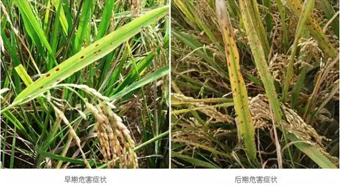
Symptoms of rice flax leaf spot disease
Hazard characteristics:
It can be affected from the seedling stage to the harvest stage, and the aboveground part of the rice plant can be harmed, mainly causing damage to the leaves.
Seed germination is affected: the bud sheath becomes brown, the buds are not extracted, and the cotyledons are dead.
Infected with leaves: brown spots at the beginning, gradually enlarged into sesame grain size, central brown to gray, brownish edge elliptic lesions, with different shades of yellow halo; severe irregularities become large irregular spots; diseased leaves from tip to Dry inside, black mold on the dead seedlings.
Leaf sheath infection: the initial dark brown, the edge is light brown, water-stained oval lesions, followed by the center taupe irregular large spots.
Incidence of the neck and branches: The affected part is dark brown, causing the ear to dry.
Infected with grain: The grain gray of the early damage is expanded to the whole grain to cause the valley. In the later stage, the lesions are small and the edges are not obvious. In severe cases, the grain is brittle and brittle. When wet, the disease minister has a black velvet mold layer.
Control method:
1 Deep tillage and mites, reduce the source of bacteria; control weeds in the field; pay attention to drainage in acidic soil, apply lime properly; apply shallow irrigation; increase application of decomposed organic fertilizer, increase phosphorus and potassium fertilizer, and improve disease resistance of plants.
2 Seed disinfection: 25% prochloraz cream 2,000-3,000 times solution, or 50% Fumei double wettable powder 500 times solution, soak seeds for 48 hours, remove and wash, germination, sowing.
3 In the stage from heading to milking, to protect the flag leaf, ear neck and grain from infestation, spray once every 4 to 7 days before the rice break and at the heading stage, and use the difenoconazole ring. The prevention and treatment of oxazole, azoxystrobin and diarrhea.
Rice seedling disease
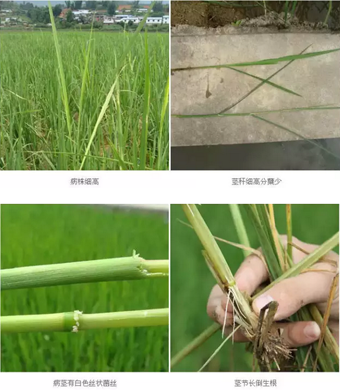
Rice seedling disease symptoms
Hazard characteristics:
The damaged rice seedlings are slender, thin, pale, and the sheath is elongated. It is about 2/3 higher than the normal seedlings. The roots are weak, the tillers are slow and few, the internodes are lengthened, and a large number of inverted fibrous roots are formed, especially the base section. More, generally die before heading, even if the heading is mature, the ears are small and small, forming white ears.
Stem damage: light red or white mildew powder on the sheath; black spots in the later stage. Grain damage: severe browning, not full, pale red mold at the cracks of the glumes.
Control method:
1 Planting resistant (resistant) disease varieties; removing diseased bodies, removing diseased plants and destroying them in time; adding decomposed organic fertilizers, increasing phosphorus and potassium fertilizers, and improving plant disease resistance.
2 Seed disinfection: 25% prochloraz oil 2,000-3,000 times liquid seed dressing, or 50% Fumei double wettable powder 500 times liquid, soaking seeds for 72 hours, remove and wash, germination, sowing.
Rice downy mildew
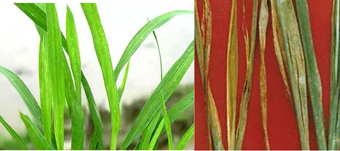
Rice downy mildew disease symptoms
Hazard characteristics:
1 The seedling stage is the main susceptibility period of rice, and the late stage of the field is beginning to show symptoms.
The leaves are yellow and white at the beginning, and then become irregular stripes on the surface, mottled leaves; the leaves are yellowish, curled, and difficult to extract; the lower leaves gradually die;
2 The sheath is slightly soft, with irregular corrugations on the surface or wrinkles and distortions, and the tiller is reduced; the roots are poorly developed and the plants are dwarfed.
3 can not be pregnant or have twisted deformed ears, the ear is small and false.
Control method:
1 Select high-lying plots to make polders, build drainage irrigation systems to prevent flooding; timely remove weeds, diseased plants, and control the spread of diseases.
2 In the early stage of the disease, it can be controlled with metalaxyl, enoylmorpholine, acetonin and mancozeb.
Rice leaf sheath spoilage
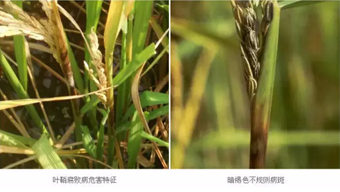
Rice leaf sheath spoilage disease symptoms
Hazard characteristics:
It can occur from the seedling stage to the heading stage, and the incidence from the booting to the heading stage is heavy. The flag leaf sheath is brown to dark brown irregular lesions, the middle color is light, the edges are dark and brown, and the multiple lesions are combined into a cloud-like lesion, sometimes with yellow halos, and then extended to the entire sheath, causing the sheath and Young ears rot.
Control method:
1 Select disease-resistant varieties; scientifically manage water, base fertilizer, topdressing early, apply fully decomposed farmyard manure, increase phosphorus and potassium fertilizer, enhance plant disease resistance; rational close planting, increase permeability.
2 Seed disinfection: 40% carbendazim suspension 500 times solution soaking for 48 hours, or 40% Heshenling WP 250 times solution, soaking seeds for 24 hours, remove and wash, germination, sowing.
3 In the early stage of the disease, tebuconazole, benzoylpropanazole and benomyl can be used for prevention and treatment.
Rice verticillium

Symptoms of rice verticillium disease
Hazard symptoms:
1 It is mainly transmitted by black-tailed spider mites, two black-tailed spider mites, and two black-tailed spider mites.
2 The leaves are thinner, the texture is softer, the chlorotic becomes pale yellow, the tillers of the plants are sharply increased, the dwarfs are clustered, and the roots are poorly developed.
3 Plants infected with seedlings can not be headed; the incidence of disease is mild in the later stage, mainly due to increased tillering, clustering, and high-yield branches of individual diseased plants, and the leaves resemble bamboo leaves.
Control method:
1 Select disease-resistant and insect-resistant varieties; the seedling stage of susceptible disease is staggered at the peak of leafhopper activity.
2 Insecticides can be sprayed during the nursery period and during the tillering stage. Imidacloprid, cyhalothrin, chlorantran, thiamethoxam and scutellaria can be used.
Rice
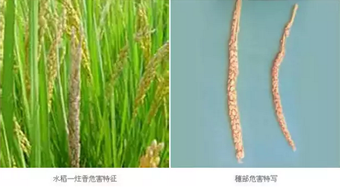
Rice a musk disease symptoms
Hazard characteristics:
The rice is damaged before heading: the pathogen grows into a grainy fruit body in the husk, and the flower core is embedded. The fruit body in the shell extends from the joint of the inner and outer buds to the outside of the shell. The shape is different, the shell is gradually black, and there is hyphae. The spikelets are entangled so that the spikelets cannot be scattered; the extracted lesions are erected in a cylindrical shape, so they are called "a column incense". The diseased ear is light blue at first, then becomes white, and the black granules are formed, which is the sub-seat of the pathogen.
Control method:
1 No disease field to keep seeds; strengthen quarantine, and strictly prohibit the transfer of diseased areas into disease-free areas.
2 Seed disinfection: first pre-soak in salt water, mud water for 4 hours, then soak seeds with warm water of 52 ~ 54 ° C for 10 minutes, germination, sowing; or soak seeds with 50% carbendazim WP 500 times for 48 hours, remove and wash Net liquid, germination, sowing.
3 In the early stage of the disease, carbendazim hydrochloride and carbendazim can be used for prevention and treatment.
Rice blight
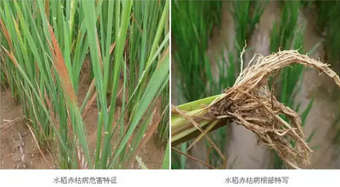
Rice blight disease symptoms
Hazard symptoms:
1 The cause of rice blight is that the rice has insufficient potassium content, the nutrient ratio is imbalanced, and the seedling quality is poor. Typical symptoms on the outside of the diseased plant are: rust-colored rust-like spots of varying sizes on the leaves, which in severe cases aggregate into plaques or strips.
2 The spot is firstly produced from the tip of the lower old leaf, then gradually becomes reddish brown downward, and finally the whole leaf is dead; the lower part of the old leaf gradually spreads to the upper part of the blade. In severe cases, only a few new leaves remain green in the whole plant, and the distant view looks like a fire.
3 The potassium-deficient and phosphorus-deficient types caused by deficiency are physiological.
4 Poisonous red dry occurs mainly in long-term flooding.
Control method:
1 Improve soil, deepen tillage layer, increase organic fertilizer, increase soil fertility, and improve soil aggregate structure.
2 Green manure as base fertilizer, should not be excessive, ploughing can not be too late; apply fully decomposed organic fertilizer, early application of potassium fertilizer, phosphate fertilizer, avoid topdressing single nitrogen fertilizer.
3 Renovate the low-lying soaking paddy fields and do the drainage ditch; the early rice should be shallowly digested and digested, and the fields should be poured in time to increase soil permeability.
4 The affected rice fields should be drained immediately, lime should be applied as appropriate, and the fields should be lightly placed to promote the sedimentation of the floating mud, so as to facilitate the early development of new roots, and spray the multi-functional high-efficiency liquid fertilizer on the foliar surface from the booting stage to the filling stage for 15 days.
Rice stem nematode
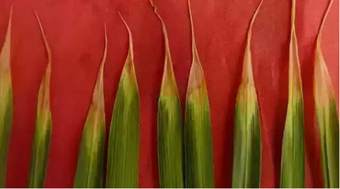
Symptoms of rice stem nematode disease
Hazard characteristics:
1 The nematode is drilled from the bud sheath and attached to the growth point, the leaf bud and the extraneous tip of the newborn. The needle is inserted into the cell to suck the juice, causing the damaged leaf to form a dry tip.
2 The symptoms at the seedling stage are not obvious. In the case of 4 to 5 true leaves, the tip of the leaves occasionally appears gray and dry, twisting the dry tip.
3 The dry tip of the diseased plant is more severe after the booting, and the flag leaf or the tip of the 2~3 leaf below it is 1-8 cm gradually yellowish, translucent, twisted and dry, and becomes gray or light brown. The boundary of the disease is obvious.
4 When the humidity is high, the dry tip leaves are flat and translucent and water-like, fluttering with the wind, and then curling after drying. Some diseased plants are not obvious, but the rice ear is lined with nematodes. Most of the plants can normally head, but the plants are short, the diseased ear is small, the mites are numerous, many are infertile, and the ears are erect.
Control method:
1 Use disease-free seeds to strengthen quarantine. It is strictly forbidden to transport seeds from ward.
2 Seed treatment: first pre-soak the rice seeds in cold water for 24 hours, then put them in warm water of 45-47 °C for 5 minutes, then put them into warm water of 52-54 °C for 10 minutes, take them out and cool them immediately, and germination. Or soak the seeds with 16% of the fresh and chlorpyrifos WP 400-700 times, wash and germination.
Rice sheath blight

Rice sheath blight disease symptoms
Hazard characteristics:
Mainly for the damage of the leaf sheath, followed by the leaves.
Leaf sheath infection: In the initial stage, a dark green water-immersed edge is formed at the surface near the water surface, and then gradually enlarges into an elliptical or moiré shape, the edge is dark brown, the middle part is grayish white and translucent, and when wet, it is grayish green.
Infected with leaves: the lesions are also cloud-like, with yellowish edges. When the disease is fast, the lesions are stained green and the leaves are quickly rotted.
Stalk infection: Symptoms like leaves, later yellow-brown, easy to fold.
Panicle neck disease: the first wet-blue-black, often can not head, more ears in the valley, thousands of weight decreased. When the humidity is high, the disease minister produces white reticular hyphae, and then forms sclerotia.
Control method:
1 Select resistant (resistant) disease varieties; salvage sclerotia, reduce bacterial sources; scientifically manage water, implement the principle of “pre-shallow, medium-sun, and post-wet†water, avoid long-term deep irrigation or excessive field drying; rational fertilization, implementation The principle of “applying sufficient base fertilizer, early application of topdressing and flexible topdressing†to enhance plant growth; rational close planting and increased permeability.
2 The rate of late-stage disease points is 15%, that is, the application of the drug is controlled. The following agents can be used: benzoyl-propiconazole, epoxiconazole, or hexaconazole.
3 At the booting stage, when the incidence rate of the plexus reaches 10%, the condition still develops, and the drug is sprayed once with 2,400-3,000 times of 30% benzyl-propiconazole emulsifiable concentrate.
rice blast

Symptoms of rice blast disease
Hazard characteristics:
Because of the damage period and location, it is divided into nursery, leafhopper, thrift, panicle, and grain.
Nursery: occurred before the three leaves, the diseased yellow-brown died.
Leaf sputum: Chronic lesions, mostly fusiform, brown at the edges, grayish-white at the center, yellow halo, with brown necrotic lines extending to both ends; acute lesions, usually occurring on susceptible varieties, forming dark green near-circular Or elliptical lesions, brown mold on both sides of the leaves.
Thrift: often occurs after heading, the initial brown spots appear, and then gradually expand the knot, making the whole section black and necrotic, easy to break, the early formation of white ears.
Panicle neck: Initially formed a small brown spot, which expands to make the neck of the ear brown, also causing white ears, causing the late Shigaya.
Grain mites: brownish brown edges and grayish white spots in the middle.
Control method:
1 Selection of resistant (resistant) disease varieties; scientific tube water, base fertilizer foot, early fattening, application of fully decomposed farmyard manure, increased application of phosphorus and potassium fertilizer, enhance plant disease resistance; reasonable close planting, increase permeability.
2 In the early stage of the disease, the control of Indigo, Sulfur, Tricyclazole and Tricyclazole was used. The severely ill areas should be controlled twice, with an interval of 7 to 10 days.
Rice bacterial blight

Rice bacterial blight disease symptoms
Hazard characteristics:
It can be harmed throughout the growth period, the most serious damage in the seedling stage and tillering stage, and all organs can be infected, and the leaves are most susceptible to disease.
1 Generally, there are chlorotic and yellow spots. When the weather is wet, the milky white spots are visible on the diseased leaves. After drying, they form yellow small rubber particles, which are easy to fall off. At the beginning of the tillering stage, the dead heart seedlings appeared, and the leaves of the diseased plant heart or the leaves of the heart layer 1 to 2 layers showed signs of water loss, reeling, and bruising, and finally died.
2 After the bacterial leaf blight is formed, the other leaves are gradually curled up. Finally, the whole plant is dead, peeling off the heart of the new blue roll or the broken stem or cutting off the diseased leaf. White bacteria pus spilled. Can be divided into leaf dry, acute wilting, yellowing three types.
Control method:
1 Strengthen the management of fertilizer and water, wet irrigation in the rainy season, base fertilizer, early fattening, application of fully decomposed farmyard manure, increase of phosphorus and potassium fertilizer, enhance plant disease resistance; timely and moderate roasting.
2 Soaking seeds: soaking seeds with immersed fruit or strong chlorine, and germination after routine washing with strong chlorin.
3 In the early stage of the disease, it is possible to use leaf cumin, chlorobromoisocyanuric acid, and streptomycin sulfate for agricultural use.
Rice bacterial leaf streak

Symptoms of bacterial leaf streak disease in rice
Hazard characteristics:
1 Rice bacterial leaf streak is mainly harmful to leaves. It is a dark green water-immersed translucent small spot, which rapidly expands into a yellow-brown thin line or a short dotted line streak between the veins, and the lesions are infiltrated green at both ends.
2 Many spots of yellow-like pus are often spilled on the lesions. After drying, they are yellow gelatinous granules, which are not easy to fall off. When the disease is serious, they merge into irregular yellow to white spots, similar to white leaves, but many are visible to light. Translucent strips.
3 When the disease is severe, the leaves are curled, and the field is yellowish white, causing early death or inability to head.
Control method:
1 Take comprehensive measures based on prevention: strengthen quarantine, control disease transmission; select resistant varieties; scientifically manage water, base fertilizer, topdressing early, apply fully decomposed farmyard manure, increase phosphorus and potassium fertilizer, and enhance plant disease resistance Reasonable close planting to increase permeability.
2 Soaking seeds: The seeds are pre-soaked with water for 12 hours, then soaked with 85% trichloroisocyanuric acid wettable powder for 300 hours, and then germinated for germination.
3 In the early stage of the disease, chlorobromoisocyanuric acid, neutrophin, trichloroisocyanuric acid, etc. can be used for prevention and treatment.
Rice false disease
  

Rice smut disease symptoms
Hazard characteristics:
1 occurs only in the ear, which is harmful to the grain. The mycelial mass is formed in the affected grain, and the inner and outer buds are split, revealing pale yellow block-like protrusions, and then gradually engulfing the whole glory, showing a black-green color.
2 Initially, a layer of film is wrapped, and then ruptured, and the dark green powder is scattered, that is, the thick sputum spores of the pathogen, and some of them are black flat sclerotia on both sides, and the wind and rain are easy to fall off.
Control method:
1 Selection of resistant (resistant) disease varieties; avoiding disease field retention, deep ploughing and burying sclerotia, removing and destroying diseased grains at the time of onset; scientific tube water, bottom fertilizer foot, top dressing early, applying fully decomposed farmyard manure, increasing phosphorus application Potassium fertilizer, enhance plant disease resistance; reasonable close planting, increase permeability.
2 The seed dressing can be mixed with 50 ml of 3% diphenyl ether methylcyclazole suspension seed coating agent.
3 In the early stage of the disease, tebuconazole, trichobacteria, tebuconazole, nitrile benzoxazole, etc. can be used for prevention and treatment.
Rice bacterial base rot

Symptoms of bacterial bacterial rot disease in rice
Hazard characteristics:
1 Mainly damage the root section and stem base of rice. In general, the tillering stage of rice begins to occur. In the initial stage, water-immersed elliptical spots are formed on the sheath of the proximal soil stem, and then expanded into irregular large spots with brown edges and white at the center.
2 Severe diseased plant heart leaf blue roll, after the yellow, like aphid damage to the heart and seedlings, then the roots of the diseased plant become black and rot, easy to pull off, have foul odor, even the leaves from the top down, yellow, even the whole plant .
Control method:
1 Selection of resistant (resistant) disease varieties; scientific tube water, base fertilizer foot, early fattening, application of fully decomposed farmyard manure, increased application of phosphorus and potassium fertilizer, enhance plant disease resistance; reasonable close planting, increase permeability.
2 In the early stage of the disease, it can be controlled with thiabium copper, thidium copper and 50% trichloroisocyanuric acid, spray once every 5 to 7 days, and spray 3 to 4 times.
Rice black streaked dwarf disease

Symptoms of rice black streaked dwarf disease
Hazard characteristics:
The disease is mainly transmitted by the gray planthopper, followed by white-backed locusts and leucorrhea. The diseased plants increased in tillering, the leaves were short, wide and stiff, and the green leaves. The veins and stems of the leaves were initially waxy white, and then turned into brown short-striped tumors with no heading or small ears and poor fruiting.
Seedling stage: The heart leaves grow slowly, the leaves are short, wide, stiff, green, and the veins have irregular waxy white knobs, which turn dark brown. The roots are short, the plants are short, do not head, and often die early.
The disease at the tillering stage: the new hernia is the first symptom, the main stem and the early tiller can still extract the short diseased ear, but the diseased ear is confined in the leaf sheath.
Onset of jointing: the flag leaf is short, the neck is short, and the seed setting rate is low. There are short strips of tumor on the back and stem.
Control method:
1 Select resistant (resistant) disease varieties; remove weeds in the field.
2 timely control of insects, can be controlled by chlorantame, thiamethoxam, pymetrozine, buprofezin.
3 In the early stage of the disease, Ningnanmycin, lentinan, and chitosan can be used to alleviate.
Rice bacterial brown streak

Symptoms of bacterial brown streak disease in rice
Hazard symptoms:
Both seedling and adult stages can be affected.
Inoculation at the seedling stage: brown spots appear on the leaves or sheaths, and then spread into purple-brown long-spotted spots with clear edges, sometimes as long as the leaves; the diseased seedlings withered or diseased leaves fall off, and the plants are short.
Adult stage disease: first in the middle of the blade of the mid-vein, the first water-immersed yellow-white, the posterior along the veins extended up to the tip of the leaf, down to the base of the sheath to form a yellow-brown to dark brown stripe, the disease tissue is brittle and easy to fold After the whole leaf curls die.
Leaf sheath infection: irregular plaques, yellowing afterwards, and finally all rot.
Heart disease: Can not be extracted, died in the leaf mites, pulled out the rancid smell, squeezed by the milky white to light yellow bacteria liquid.
Control method:
1 Establish a reasonable irrigation and drainage system to prevent flooding of rice fields and timely drainage; increase the application of organic fertilizers, and rationally cooperate with nitrogen, phosphorus and potassium fertilizers to enhance the disease resistance of plants.
2 In the early stage of the disease, it can be controlled by chlorobromoisocyanuric acid, neutrophin and trichloroisocyanuric acid.
Rice stripe disease

Rice stripe disease
Hazard symptoms:
It is only transmitted by the gray planthopper, and once it is poisoned, it can be used for life and through the egg.
Seedling stage: chlorotic yellow and white spots appear at the base of the initial plant heart, and then expand into yellow stripes parallel to the veins, and the stripes remain green; the diseased 糯, japonica and high-stalked japonica rice leaves are yellow and white, soft, curly and drooping, showing dryness Heart-shaped; dwarf glutinous rice is not heart-shaped, yellow-green inter-stripes appear, tillering is reduced, and the diseased plants die early.
The disease occurs at the tillering stage: the chlorotic macula appears in the base of the first leaf of the initial plant, and then forms irregular yellow-white streaks. The old leaves are not obvious, the diseased plants are often dry, the booting or ear small deformity is not true; the japonica is not dry. Half of the japonica rice showed up.
After the jointing disease: yellow-green stripes appeared in the lower part of the flag leaf, and all types of rice were not dry, but the heading was deformed and the fruiting was rare, forming a "false white ear".
Control method:
1 Planting resistant (resistant) disease varieties; adjusting sowing date, avoiding the migratory period of gray planthoppers during transplanting period; controlling grass weeds in the field; ploughing and smashing after harvest in autumn, reducing the number of wintering of flying locusts.
2 timely control of insects, can be controlled by chlorantame, thiamethoxam, pymetrozine, buprofezin.
3 In the early stage of the disease, yoghurt polysaccharide, nymidine, and chlorobromoisocyanuric acid can be used for prevention and treatment.
Rice flax leaf spot

Symptoms of rice flax leaf spot disease
Hazard characteristics:
It can be affected from the seedling stage to the harvest stage, and the aboveground part of the rice plant can be harmed, mainly causing damage to the leaves.
Seed germination is affected: the bud sheath becomes brown, the buds are not extracted, and the cotyledons are dead.
Infected with leaves: brown spots at the beginning, gradually enlarged into sesame grain size, central brown to gray, brownish edge elliptic lesions, with different shades of yellow halo; severe irregularities become large irregular spots; diseased leaves from tip to Dry inside, black mold on the dead seedlings.
Leaf sheath infection: the initial dark brown, the edge is light brown, water-stained oval lesions, followed by the center taupe irregular large spots.
Incidence of the neck and branches: The affected part is dark brown, causing the ear to dry.
Infected with grain: The grain gray of the early damage is expanded to the whole grain to cause the valley. In the later stage, the lesions are small and the edges are not obvious. In severe cases, the grain is brittle and brittle. When wet, the disease minister has a black velvet mold layer.
Control method:
1 Deep tillage and mites, reduce the source of bacteria; control weeds in the field; pay attention to drainage in acidic soil, apply lime properly; apply shallow irrigation; increase application of decomposed organic fertilizer, increase phosphorus and potassium fertilizer, and improve disease resistance of plants.
2 Seed disinfection: 25% prochloraz cream 2,000-3,000 times solution, or 50% Fumei double wettable powder 500 times solution, soak seeds for 48 hours, remove and wash, germination, sowing.
3 In the stage from heading to milking, to protect the flag leaf, ear neck and grain from infestation, spray once every 4 to 7 days before the rice break and at the heading stage, and use the difenoconazole ring. The prevention and treatment of oxazole, azoxystrobin and diarrhea.
Rice seedling disease

Rice seedling disease symptoms
Hazard characteristics:
The damaged rice seedlings are slender, thin, pale, and the sheath is elongated. It is about 2/3 higher than the normal seedlings. The roots are weak, the tillers are slow and few, the internodes are lengthened, and a large number of inverted fibrous roots are formed, especially the base section. More, generally die before heading, even if the heading is mature, the ears are small and small, forming white ears.
Stem damage: light red or white mildew powder on the sheath; black spots in the later stage. Grain damage: severe browning, not full, pale red mold at the cracks of the glumes.
Control method:
1 Planting resistant (resistant) disease varieties; removing diseased bodies, removing diseased plants and destroying them in time; adding decomposed organic fertilizers, increasing phosphorus and potassium fertilizers, and improving plant disease resistance.
2 Seed disinfection: 25% prochloraz oil 2,000-3,000 times liquid seed dressing, or 50% Fumei double wettable powder 500 times liquid, soaking seeds for 72 hours, remove and wash, germination, sowing.
Rice downy mildew

Rice downy mildew disease symptoms
Hazard characteristics:
1 The seedling stage is the main susceptibility period of rice, and the late stage of the field is beginning to show symptoms.
The leaves are yellow and white at the beginning, and then become irregular stripes on the surface, mottled leaves; the leaves are yellowish, curled, and difficult to extract; the lower leaves gradually die;
2 The sheath is slightly soft, with irregular corrugations on the surface or wrinkles and distortions, and the tiller is reduced; the roots are poorly developed and the plants are dwarfed.
3 can not be pregnant or have twisted deformed ears, the ear is small and false.
Control method:
1 Select high-lying plots to make polders, build drainage irrigation systems to prevent flooding; timely remove weeds, diseased plants, and control the spread of diseases.
2 In the early stage of the disease, it can be controlled with metalaxyl, enoylmorpholine, acetonin and mancozeb.
Rice leaf sheath spoilage

Rice leaf sheath spoilage disease symptoms
Hazard characteristics:
It can occur from the seedling stage to the heading stage, and the incidence from the booting to the heading stage is heavy. The flag leaf sheath is brown to dark brown irregular lesions, the middle color is light, the edges are dark and brown, and the multiple lesions are combined into a cloud-like lesion, sometimes with yellow halos, and then extended to the entire sheath, causing the sheath and Young ears rot.
Control method:
1 Select disease-resistant varieties; scientifically manage water, base fertilizer, topdressing early, apply fully decomposed farmyard manure, increase phosphorus and potassium fertilizer, enhance plant disease resistance; rational close planting, increase permeability.
2 Seed disinfection: 40% carbendazim suspension 500 times solution soaking for 48 hours, or 40% Heshenling WP 250 times solution, soaking seeds for 24 hours, remove and wash, germination, sowing.
3 In the early stage of the disease, tebuconazole, benzoylpropanazole and benomyl can be used for prevention and treatment.
Rice verticillium

Symptoms of rice verticillium disease
Hazard symptoms:
1 It is mainly transmitted by black-tailed spider mites, two black-tailed spider mites, and two black-tailed spider mites.
2 The leaves are thinner, the texture is softer, the chlorotic becomes pale yellow, the tillers of the plants are sharply increased, the dwarfs are clustered, and the roots are poorly developed.
3 Plants infected with seedlings can not be headed; the incidence of disease is mild in the later stage, mainly due to increased tillering, clustering, and high-yield branches of individual diseased plants, and the leaves resemble bamboo leaves.
Control method:
1 Select disease-resistant and insect-resistant varieties; the seedling stage of susceptible disease is staggered at the peak of leafhopper activity.
2 Insecticides can be sprayed during the nursery period and during the tillering stage. Imidacloprid, cyhalothrin, chlorantran, thiamethoxam and scutellaria can be used.
Rice

Rice a musk disease symptoms
Hazard characteristics:
The rice is damaged before heading: the pathogen grows into a grainy fruit body in the husk, and the flower core is embedded. The fruit body in the shell extends from the joint of the inner and outer buds to the outside of the shell. The shape is different, the shell is gradually black, and there is hyphae. The spikelets are entangled so that the spikelets cannot be scattered; the extracted lesions are erected in a cylindrical shape, so they are called "a column incense". The diseased ear is light blue at first, then becomes white, and the black granules are formed, which is the sub-seat of the pathogen.
Control method:
1 No disease field to keep seeds; strengthen quarantine, and strictly prohibit the transfer of diseased areas into disease-free areas.
2 Seed disinfection: first pre-soak in salt water, mud water for 4 hours, then soak seeds with warm water of 52 ~ 54 ° C for 10 minutes, germination, sowing; or soak seeds with 50% carbendazim WP 500 times for 48 hours, remove and wash Net liquid, germination, sowing.
3 In the early stage of the disease, carbendazim hydrochloride and carbendazim can be used for prevention and treatment.
Rice blight

Rice blight disease symptoms
Hazard symptoms:
1 The cause of rice blight is that the rice has insufficient potassium content, the nutrient ratio is imbalanced, and the seedling quality is poor. Typical symptoms on the outside of the diseased plant are: rust-colored rust-like spots of varying sizes on the leaves, which in severe cases aggregate into plaques or strips.
2 The spot is firstly produced from the tip of the lower old leaf, then gradually becomes reddish brown downward, and finally the whole leaf is dead; the lower part of the old leaf gradually spreads to the upper part of the blade. In severe cases, only a few new leaves remain green in the whole plant, and the distant view looks like a fire.
3 The potassium-deficient and phosphorus-deficient types caused by deficiency are physiological.
4 Poisonous red dry occurs mainly in long-term flooding.
Control method:
1 Improve soil, deepen tillage layer, increase organic fertilizer, increase soil fertility, and improve soil aggregate structure.
2 Green manure as base fertilizer, should not be excessive, ploughing can not be too late; apply fully decomposed organic fertilizer, early application of potassium fertilizer, phosphate fertilizer, avoid topdressing single nitrogen fertilizer.
â‘¢ æ”¹é€ ä½Žæ´¼æµ¸æ°´ç”°ï¼Œåšå¥½æŽ’水沟;早稻è¦æµ…çŒå‹¤çŒï¼ŒåŠæ—¶è€˜ç”°ï¼Œå¢žåŠ 土壤通é€æ€§ã€‚
â‘£ å‘病稻田è¦ç«‹å³æŽ’水,酌施石ç°ï¼Œè½»åº¦æç”°ï¼Œä¿ƒè¿›æµ®æ³¥æ²‰å®žï¼Œä»¥åˆ©æ–°æ ¹æ—©å‘ã€æ°´ç¨»å•ç©—期至çŒæµ†æœŸå¶é¢å–·æ–½å¤šåŠŸèƒ½é«˜æ•ˆæ¶²è‚¥éš”15天1次。
水稻干尖线虫病

水稻干尖线虫病å±å®³ç—‡çŠ¶
å±å®³ç‰¹å¾ï¼š
①线虫从芽鞘ç¼é’»å…¥ï¼Œé™„于生长点ã€å¶èŠ½åŠæ–°ç”Ÿå«©å¶å°–端的细胞外,以å»é’ˆåˆºå…¥ç»†èƒžå¸é£Ÿæ±æ¶²ï¼Œè‡´è¢«å®³å¶å½¢æˆå¹²å°–。
â‘¡ 苗期症状ä¸æ˜Žæ˜¾ï¼Œåœ¨4~5片真å¶æ—¶å¶å°”出现å¶å°–ç°ç™½è‰²å¹²æž¯ï¼Œæ‰æ›²å¹²å°–。
â‘¢ ç—…æ ªå•ç©—åŽå¹²å°–更严é‡ï¼Œå‰‘å¶æˆ–其下2~3å¶å°–端1~8 cmæ¸æž¯é»„,åŠé€æ˜Žï¼Œæ‰æ›²å¹²å°–,å˜ä¸ºç°ç™½æˆ–æ·¡è¤è‰²ï¼Œç—…å¥éƒ¨ç•Œé™æ˜Žæ˜¾ã€‚
â‘£ 湿度大时,干尖å¶ç‰‡å±•å¹³å‘ˆåŠé€æ˜Žæ°´æ¸çŠ¶ï¼Œéšé£Žé£˜åŠ¨ï¼Œéœ²å¹²åŽåˆå¤å·æ›²ã€‚æœ‰çš„ç—…æ ªä¸æ˜¾ç—‡ï¼Œä½†ç¨»ç©—带有线虫,大多数æ¤æ ªèƒ½æ£å¸¸æŠ½ç©—,但æ¤æ ªçŸ®å°ï¼Œç—…穗较å°ï¼Œç§•ç²’多,多ä¸å•ï¼Œç©—直立。
Control method:
â‘ é€‰ç”¨æ— ç—…ç§åï¼ŒåŠ å¼ºæ£€ç–«ï¼Œä¸¥ç¦ä»Žç—…区调è¿ç§å。
â‘¡ ç§å处ç†ï¼šå…ˆå°†ç¨»ç§é¢„浸于冷水ä¸24å°æ—¶ï¼Œç„¶åŽæ”¾åœ¨45~47℃温水ä¸5分钟æ温,å†æ”¾å…¥52~54℃温水ä¸æµ¸10分钟,å–出立å³å†·å´ï¼Œå‚¬èŠ½æ’ç§ã€‚或用16%咪鲜·æ€èžŸä¸¹å¯æ¹¿æ€§ç²‰å‰‚400~700å€æ¶²æµ¸ç§ï¼Œæ´—净åŽå‚¬èŠ½æ’ç§ã€‚
More pesticide knowledge , please pay attention to China Pesticide Network
(æ¥æºï¼šå†œäººå†œæŠ€ï¼‰
Custom Webbing,Elastic Webbing,100% Polyester Webbing,High-Strength Webbing
SHAOXING GULI BELTING CO., LTD , https://www.gulilifting.com